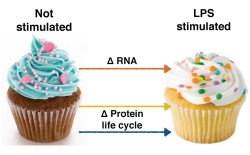The intricate web of gene expression control mechanisms
Lipopolysaccharides (LPSs) on the surface of microbes trigger very strong immune responses through interaction with immune cells, especially antigen presenting cells such as dendritic cells (DCs). The EXPRESSION DYNAMICS team investigated control of the immune response of mouse DCs stimulated with the pathogen component LPS. Looking at RNA levels as well as the dynamics of the protein life cycle (production and degradation), they produced a whole picture of the gene expression changes during this immune response. As Marko Jovanovic, principal researcher on the project outlines, ‘We aimed to create a global model, one where we know how much each type of regulatory layer contributes to each gene’s expression.’ A new model – the icing on the cake The result is a model where new cellular functions, necessary for the acute immune response for example, are primarily driven through control at the level of RNA expression. The pre-existing proteome however, is also modified, in order to adapt to the activated cell state, and this is through regulation of protein production and/or breakdown, the protein lifecycle. ‘We termed this the cupcake model where the attractive part that people very often focus on is the icing and changes in the icing are analogous to the part adjusted by mRNA regulation. The cake part, also essential, but often and unfairly neglected, is analogous to the housekeeping genes which also need to change and, according to our results, involves the protein lifecycle.’ explains Marko Jovanovic. Extending the systems biology model to stimulation of nerve cells, the researchers are now looking at how different classes of genes are regulated in space and time in cell bodies and dendrites of these stimulated neurons. By applying the same proteomics and transcriptomics approach as for the LPS-stimulated DCs, the researchers will find out for thousands of genes in parallel if protein changes are differently regulated in specific cellular compartments, such as cell bodies and dendrites. Identifying the genes responsible for regulation Traditionally, gene knock-out screens are used to find the main regulators of a biological process of interest. Although already done in simple model organisms such as yeast for decades, it is much harder in mammalian systems, especially cell lines, and often involves strong phenotypic readouts such as survival. In contrast, EXPRESSION DYNAMICS developed a new marker-based genome wide screen to identify the regulators of the expression changes of a gene of interest. A more subtle approach, it enables screening for nearly every biological process of interest. Using the modified CRISPR based genome-wide screen, again with DCs stimulated by LPS, the team found many unknown regulators of the LPS-induced immune response. They then classified the genes into functional modules with distinct effects on the LPS response. Gene control mechanism research in the future clinic The patent application filed for the delivery, use and therapeutic applications of the CRISPR-CAS systems and modelling gives an indication of the enormous scope of this technology. Identification of genes involved in immune system leukocyte responses and modelling of faulty leukocyte action and associated diseases are perhaps the most obvious use. The next step, testing possible chemical and or gene therapies, stands to be a powerful basis for treatment. Marko Jovanovic summarises its potential biomedical research power. ‘Provided there is a detectable marker, this marker-based genome wide screen in primary mammalian cells will allow us to apply unbiased genetic screening in nearly every available system and hopefully identify primary targets for disease treatment.’
Keywords
Gene expression control, immune response, EXPRESSION DYNAMICS, dendritic cell, nerve cell

